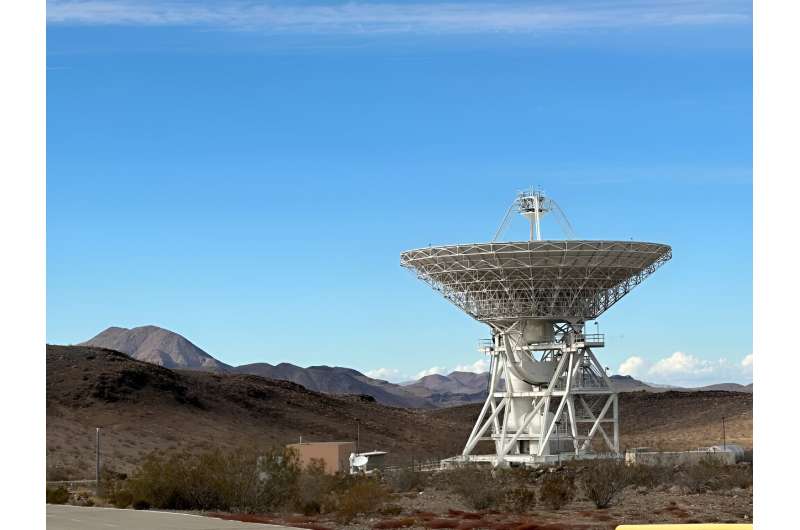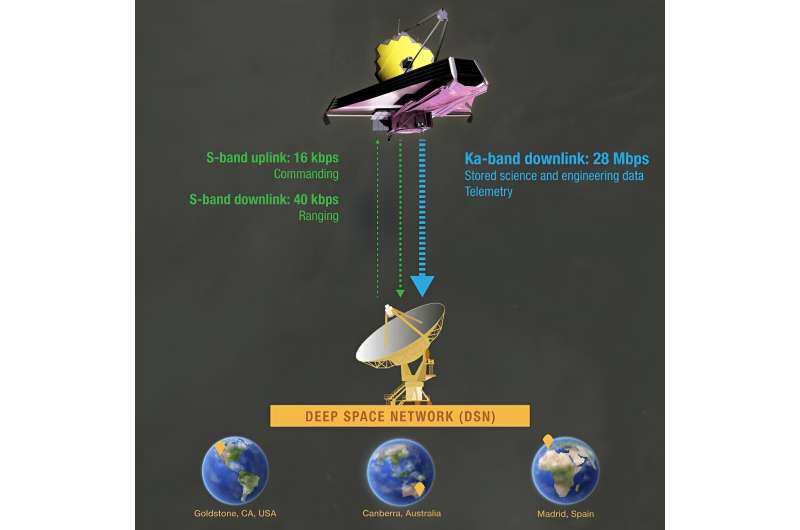Talking with Webb using the Deep Space Network

NASA's James Webb Space Telescope is nearly 1 million miles (1.5 million kilometer) away from Earth, orbiting around the sun-Earth Lagrange point 2. How do we send commands and receive telemetry—the science and engineering data from the observatory—from that far away? We use the DSN (Deep Space Network) to communicate with the observatory. We receive data when we have a contact with Webb using a DSN antenna
Sandy Kwan, the mission interface manager for Webb within the DSN, notes that "each mesmerizing Webb image that has graced our screens would not have been possible without the support of the DSN antennas and personnel, the backbone of interplanetary communication."
The DSN has three sites around the world, each positioned 120 degrees apart. There are antennas in Goldstone, California; Canberra, Australia; and Madrid, Spain. This allows us to communicate with Webb at any time of day, as the Earth rotates. The DSN is managed by NASA's Jet Propulsion Laboratory (JPL) in Southern California. Kari Bosley, the lead Webb mission planner at the Space Telescope Science Institute (STScI), walks us through more of this communication process between Webb and the DSN.
"How do we plan contact time with Webb? It's not as simple as picking up the phone and calling the telescope. In order for Earth to connect with Webb there are a few things that happen prior to scheduling a contact. On average, the Webb mission operations center connects with the observatory at least two to three times in a 24-hour period. There are mission planners at STScI where the Mission Operations Center (MOC) is located, mission schedulers at JPL, and of course at the DSN complexes. The mission planners at STScI work together with the mission schedulers at JPL to create contacts with Webb.
"How do we know when we can contact Webb? The Flight Dynamics Facility at NASA's Goddard Space Flight Center sends the MOC at STScI the view periods in which the observatory is visible from those three different DSN sites. The mission scheduler compares those times to what is available in the scheduling system where other missions are competing for time with their spacecraft.
"All missions require specific amounts of time to communicate with their spacecraft, and the timing depends on where the spacecraft are in space. There are times when conflicts between multiple missions request the same resource at the same time. When this happens, our mission scheduler at JPL will negotiate with other missions to come to a compromise that satisfies all of the missions. Once all negotiations are complete, schedules are sent to the mission planners up to six months in advance. The scheduling for the first eight weeks is fixed, with no changes allowed unless there is an emergency or important event with a spacecraft. The later periods are subject to continuing negotiations.

"Each of the DSN complexes has different types of antennas, including 70-meter (230-foot in diameter), 34-meter (111-foot in diameter), and 26-meter (85-foot in diameter) antennas.
"The DSN complexes use the 34-meter antennas to talk with Webb with the 70-meter antennas as a backup. The DSN supports different radio frequency allocations, such as the S-band and Ka-band frequencies that Webb uses. S-band has a lower bandwidth, and we use that to send commands to the spacecraft (e.g., start recorder playback), to receive engineering telemetry to monitor the health and safety of the observatory, and for ranging. Ranging is the process of determining Webb's position and trajectory by the delay between when the signal is sent up and when it is received back on the ground.
"We use Ka-band to downlink stored science and engineering data, and some telemetry from the spacecraft. If we used S-band to downlink data, it would take many days to download each day's data. With Ka-band, it takes much less time, and we can usually complete download all of the stored data in a couple of hours. The high gain antenna on Webb is used for Ka-band downlink and the medium gain antenna is used for S-band uplink and downlink when both antennas are pointed directly at the complex for a contact. Most of our contacts are two to six hours in length. Normally, we request at least four-hour contacts. Since DSN hosts almost 40 different missions, scheduling is complicated.
"There are times when our contacts are very short and times when they are longer. In each contact, it is important to downlink as much data as we can since the telescope continually makes science observations and acquires more data. When we are not in contact, the telescope continues to autonomously perform science observations. These data are stored on a solid-state recorder and downlinked on our next contact. After the Webb MOC at STScI receives the data and ingests them into the Barbara A. Mikulski Archive for Space Telescope for processing and calibration, the observers will receive the data from their observations.
"Those interested in seeing the downlink and uplink between NASA missions and the DSN can visit the 'Deep Space Network Now' website at https://eyes.nasa.gov/dsn/dsn.html. You can view the missions and resources that are actively being used at DSN."
Provided by NASA's Goddard Space Flight Center
No comments:
Post a Comment